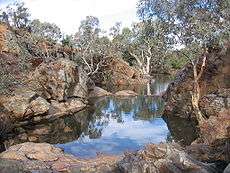Ephemerality



Ephemerality (from Greek εφήμερος – ephemeros, literally "lasting only one day"[1]) is the concept of things being transitory, existing only briefly. Typically the term ephemeral is used to describe objects found in nature, although it can describe a wide range of things, including human artifacts intentionally made to last for only a temporary period, in order to increase their perceived aesthetic value. With respect to unique performances, for example, it has been noted that "[e]phemerality is a quality caused by the ebb and flow of the crowd's concentration on the performance and a reflection of the nostalgic character of specific performances".[2] Because different people may value the passage of time differently, "the concept of ephemerality is a relative one".[3]
Natural examples
Geographical features
An ephemeral waterbody is a wetland, spring, stream, river, pond or lake that only exists for a short period following precipitation or snowmelt. They are not the same as intermittent or seasonal waterbodies, which exist for longer periods, but not all year round.
Examples of ephemeral streams are the Luni river in Rajasthan, India, Ugab River in Southern Africa, and a number of small ephemeral watercourses that drain Talak in northern Niger. Other notable ephemeral rivers include the Todd River and Sandover River in Central Australia as well as the Son River, Batha River and the Trabancos River.
Any endorheic basin, or closed basin, that contains a playa or dry lake at its drainage lowpoint can become an ephemeral lake. Examples include Lake Carnegie in Western Australia, Lake Cowal in New South Wales, Mystic Lake and Rogers Lake in California, and Sevier Lake in Utah. Even the driest and lowest place in North America, Death Valley (more specifically Badwater Basin), became flooded with a short-lived ephemeral lake in the spring of 2005.[4]
There are also ephemeral islands such as Banua Wuhu and Home Reef. These islands appear when volcanic activity increases their height above sea level, but disappear over several years due to wave erosion. Bassas da India, on the other hand, is a near-sea level island that appears only at low tide.
Biological processes
Many plants are adapted to an ephemeral lifestyle, in which they spend most of the year or longer as seeds before conditions are right for a brief period of growth and reproduction. The spring ephemeral plant mouse-ear cress is a well-known example.
Animals can be ephemeral, with brine shrimp and the mayfly being examples. The placenta is considered an ephemeral organ present during gestation and pregnancy.
Ephemeral artifacts
Ephemeral can also be used as an adjective to refer to a fast-deteriorating importance or temporary nature of an object to a person. Brands are notoriously ephemeral assets, and magazine publishing was once much more ephemeral than it is today, as was television programming. A film made by a particular sponsor for a specific purpose other than as a work of art may be called an ephemeral film, because the film itself can continue to exist after the social or commercial context for its creation has disappeared.
A number of art forms can be considered ephemeral because of their temporary nature. Early land art and all sand sculptures, ice sculptures and chalk drawings on footpaths are examples of ephemeral art. G. Augustine Lynas and Duthain Dealbh create ephemeral sculptures.
See also
| Look up ephemeral in Wiktionary, the free dictionary. |
References
- ↑ Ephemeros, Henry George Liddell, Robert Scott, "A Greek-English Lexicon", at Perseus
- ↑ Will Straw, Alexandra Boutros, Circulation and the City: Essays on Urban Culture (2010), p. 148.
- ↑ Ronald Beiner, Political Philosophy: What It Is and Why It Matters (2014), p. 10.
- ↑ "Death Valley Alive With Wildflowers", MSNBC (March 14, 2005).
Further reading
- Christine Buci-Glucksmann, Esthetique De L'ephemere, Galilee, ISBN 2-7186-0622-3